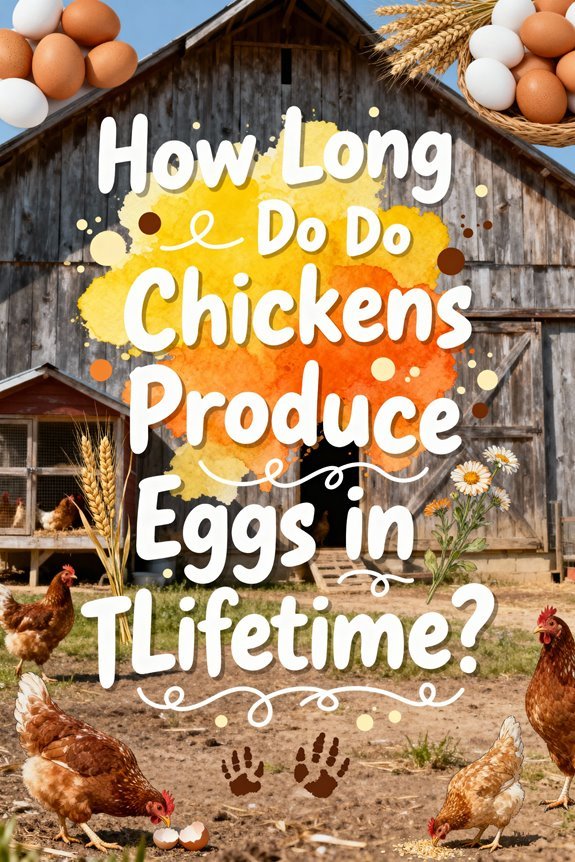How Long Do Chickens Produce Eggs in Their Lifetime?
Your chicken will start laying eggs between 16-24 weeks of age, with peak production occurring in the first two years. During this ideal period, high-producing hens can yield 250-300 eggs annually. After year three, production typically drops to about 70% of peak output. Heritage breeds can lay for 5-8 years, while commercial hybrids show steeper declines after 2-3 years. Understanding breed differences and environmental factors can greatly impact your hen’s productive lifespan.
Natural Egg-Laying Timeline for Chickens
Although chickens can live 8-10 years, their peak egg-laying period begins between 16-24 weeks of age and typically lasts for the first two years of life. Each egg requires egg formation time of 24-26 hours from start to finish. You’ll notice that natural laying patterns depend heavily on environmental factors, with daylight hours and nutrition playing vital roles in egg maturity and production schedules. High-performing breeds can produce up to 250 eggs annually during their prime laying years. Well-maintained hens typically lay 5 to 6 eggs each week under optimal conditions.
After the initial peak, your hens’ egg production will gradually decline. By year three, expect about 70% of first-year output, dropping to 60% by year four. While heritage breeds often maintain longer laying periods of 5-8 years, commercial hybrids experience steeper declines after 2-3 years. The shift toward retirement isn’t sudden – your hens will lay progressively fewer eggs until they eventually stop, usually around 6-7 years of age.
Peak Production Years and Output
The most productive period in a hen’s life spans from week 25 to 30, with ideal output peaking at 30-32 weeks of age. During this time, you’ll observe peak laying frequency of up to 250-300 eggs annually, with high-producing hens maintaining near-daily egg laying for the first 1-2 years.
Maximum output rates depend greatly on breed selection. Commercial hybrids achieve higher production levels compared to heritage breeds, potentially reaching 300 eggs per year during peak performance. You’ll need to maintain proper nutrition at 100-105 grams of feed daily per bird to support this intensive laying period. Cold weather conditions can significantly impact egg production rates throughout the year. While production naturally declines after year 3, with substantial decreases between years 4-6, you can expect a total lifetime output of 500-600 eggs over 5-6 years from a well-managed, high-producing hen.
Age-Related Decline in Egg Production
While hens maintain peak egg production during their first two years, you’ll observe a steady decline in laying rates as they age beyond this period. By age three, you’ll notice significant aging effects on both egg quantity and quality. Your older hens will produce fewer eggs with thinner, more fragile shells due to decreased shell calcification and reduced vitamin D metabolism. Black Sex Link hens demonstrate particularly strong egg-laying abilities, producing around 300 brown eggs annually during their prime laying years. A well-balanced layer feed diet containing 16-18% protein helps maintain optimal egg production throughout their laying years.
Though older hens lay larger eggs with bigger yolks, they can’t compensate for the overall decline in production. You’ll see laying rates drop from 90% to 65% or lower after the first year. The decline stems from slower follicular growth and reduced follicle recruitment, rather than changes in reproductive hormones. These physiological changes affect not only shell strength but also impact yolk composition and potential offspring viability in breeding flocks. Eventually, egg production may stop completely by age 5, leading to retirement from laying duties.
Breed-Specific Laying Patterns
Different chicken breeds exhibit distinct egg-laying patterns, with commercial layers like Leghorns producing up to 300 white eggs annually while heritage breeds like Buff Orpingtons yield 180-280 brown eggs per year. You’ll find breed advantages vary considerably, with Rhode Island Reds offering consistent production of 250-300 large brown eggs and excellent cold hardiness. Easter Egger hybrids provide unique egg variations, laying 200+ eggs in blue, green, and pink hues. Climate adaptability plays an essential role in productivity, as Mediterranean breeds excel in warm weather while dual-purpose breeds like Australorps maintain steady laying in varied conditions. Commercial hybrids typically peak for 2-3 years with lifetime totals of 500-700 eggs, while heritage breeds may lay fewer eggs annually but continue production over a longer period. Bantam varieties produce smaller sized eggs while requiring less space and resources for maintenance. The Cinnamon Queen breed consistently delivers between 250-320 eggs annually, making them an excellent choice for maximizing production. Rhode Island Reds begin their productive cycle at 18 weeks old, making them one of the earliest-laying heritage breeds available.
Backyard Vs Commercial Laying Cycles
Comparing backyard and commercial laying operations reveals distinct productivity patterns, with backyard hens producing 180-320 eggs annually versus commercial layers‘ peak output of 300 eggs during their prime laying period of 20-78 weeks.
One of the key backyard benefits is longevity, as these hens can lay eggs for 6-7 years, though with decreasing output after their first year. Commercial practices focus on maximizing short-term production through artificial lighting and specialized feeds, typically replacing hens after 72-78 weeks when productivity declines. While commercial operations maintain consistent year-round production through controlled lighting, backyard flocks follow natural seasonal cycles, including breaks for molting. You’ll find that backyard hens’ extended laying lifespan compensates for lower annual output, while commercial operations prioritize peak efficiency during a shorter productive period. Most backyard chickens maintain a natural rhythm of 4-6 eggs per week during their active laying periods.
Environmental Factors Affecting Laying Duration
Since egg production depends heavily on environmental conditions, understanding and managing these factors becomes essential for sustained laying duration. You’ll need to implement proper light management, ensuring your hens receive 14+ hours of daily light exposure while maintaining a critical 6-hour dark period. Temperature control is equally significant – excessive heat above 31°C can dramatically reduce laying periods and shell quality, though hens will gradually acclimate to cyclic heat patterns. A warm-white LED bulb provides optimal artificial lighting conditions for consistent egg production. Light intensity levels of around 50 lumens should be maintained throughout the coop for optimal egg production.
Your hens’ laying duration also hinges on stress management and nutritional balance. You’ll maximize their productive lifespan by providing a secure, predator-free environment with minimal disruptions. Having a mating rooster present can influence egg production through natural courtship behaviors. A calcium-rich diet supports extended laying periods, while inadequate nutrition can prematurely end egg production. Remember that seasonal changes naturally affect laying cycles, with peak production occurring during longer spring and summer days.
Maximizing Your Hen’s Productive Years
To maximize your laying hens’ productive years, you’ll need to carefully consider breed selection and implement thorough management strategies. While hybrid layers typically produce for 2-3 years, heritage breeds can lay for 6-8 years with proper care. Regular veterinary checkups help maintain optimal egg production through disease prevention and early intervention.
Most hens reach sexual maturity between 18-24 weeks of age when they begin laying eggs. Production breeds can start laying as early as 16 weeks old, making them ideal for quicker returns. Provide ideal feed with balanced protein, calcium, and minerals to support sustained production. You’ll enhance laying duration by implementing a natural molting cycle and maintaining 14-16 hours of daily light exposure. Focus on stress reduction through spacious housing, regular cleaning, and protection from predators.
Monitor your hens’ health through routine checks and address issues promptly. Consider dual-purpose breeds if you’re seeking balanced productivity and longevity. By following these practices and allowing for reduced production intensity after peak laying years, you can extend your hens’ egg-laying capabilities beyond standard commercial timeframes.
Common Health Issues That Impact Egg Production
Even well-maintained hens face multiple health challenges that can diminish egg production. Several critical health concerns include infectious diseases like bronchitis, which can reduce production by up to 50%, and Newcastle disease, which affects both output and egg quality. Without proper disease prevention, fowl cholera can cause 5% daily mortality rates in unvaccinated flocks. The development process of each egg requires approximately 25 hours to complete. Regular deworming with liquid dewormers helps prevent parasitic infections that can severely impact egg production. Parasitic infections present another significant threat, with internal parasites depleting nutrients and external parasites like red mites causing anemia. Chickens commonly battle lice infestations, which can be controlled through dust bathing areas where birds can naturally groom themselves. You’ll notice signs through thin shells, pale yolks, or misshapen eggs. Additionally, nutritional deficiencies, particularly calcium shortages, lead to soft-shelled eggs and reduced laying capacity. Environmental stressors, including heat and social pressure, can further compromise your flock’s productivity. Managing these issues through vaccination, proper nutrition, and environmental controls is essential for maintaining consistent egg production.


